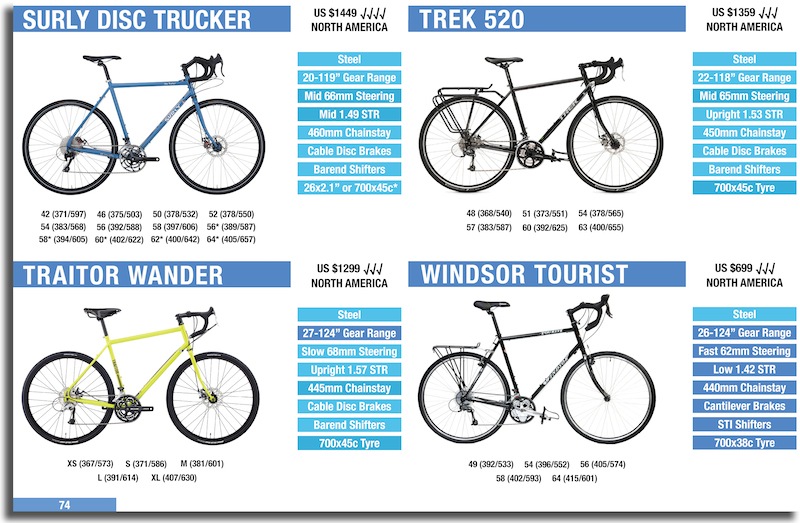Table of Contents
It’s been over five years since Cannondale had a touring bike in its line-up. I’m not sure of the reasons why they dropped their T-series bikes, but the good news is that they are back and called… the 2016 Cannondale Touring!
Cannondale are best known for their use of aluminium, a material rare in bicycle touring circles, but if used correctly it rides very well: it’s stiff, comfortable and lightweight. I’ve written extensively about frame materials in the past, and the consensus is that any material is good if it’s used well. Put it this way, I wouldn’t hesitate in bringing an aluminium touring bike on a world trip if it was made by Cannondale.
These Cannondales will likely ride slightly different to other touring bikes available; I consider them ‘light tourers’ because of the use of STI integrated shifters, road cranksets, higher-range gears and clearance for 40c tyres. Another way to look at it: they’re half way between a cyclocross and dedicated touring bike.
When comparing the frame geometry, Cannondale uses steeper angles and a shorter wheelbase to make their bikes feel faster without a load. This makes them more versatile (you could use it as a road bike/gravel bike too), but may limit you if you wanted to ride rough terrain with four panniers. Without a decent triple crankset and MTB cassette, you may be walking up those steep dirt roads! Click HERE to learn all about touring frame geometry and HERE to learn about touring bike gearing.
There will be two models available:
The 2016 Cannondale Touring Ultimate
The Touring Ultimate features an extensive range of road bike components, including Shimano Ultegra 11s hydro shifters and a road compact crankset. With parts of this calibre, the Ultimate will be a good few kilos lighter than many steel touring options – perfect for a fast tour. Like most touring bikes there’s still provision for front/rear racks, mudguards and 3x bidon cages.
The Touring Ultimate will retail for US $2660.
The 2016 Cannondale Touring 1
The Touring 1 utilises the new Shimano Tiagra 10s compact groupset. It offers a slightly wider gear range than the Ultimate (34-34 compared to 34-32) and cable disc brakes, so this could be the go-to model for riding in more remote locations. As you’d expect there’s provision for front/rear racks, mudguards and 3x bidon cages on this model.
The Touring 1 will retail for US $1620.
Who are Cannondale’s Touring Bikes Best Suited to?
If you spend most of your time on sealed roads and keep away from steep climbs, you will find Cannondales touring bikes to be very fast and capable. These bikes are a few kilograms lighter than a standard touring rig, making them a true jack-of-all-trades that excel across many road disciplines. Don’t be wary about aluminium; these guys have been working with it longer than most. With a good choice of tyre, seatpost and seat; you will feel supremely comfortable cruising along on these bikes.
Want To Compare These Touring Bikes With Dozens of Others?
Check out The Touring Bicycle Buyer’s Guide which compares touring bike steering, sizing, gear ratios, specification, pricing and more. This guide is updated annually with the latest models at no extra cost!

Helpful Resources
All About Touring Bike Brakes
Frame Materials for Bicycle Touring
How to Select Touring Bike Gearing
Understand Bicycle Frame Geometry
What’s the Difference between Cyclocross and Touring Bikes?
Touring Bikes Overview
2016 Advocate Lorax
2016 Basso Ulisse
2016 Bianchi Volpe and Lupo 2016
2016 Bombtrack Beyond
2017 Bombtrack Beyond
2016 Brodie Elan Vital
2016 Cannondale Touring
2016 Cinelli Hobootleg Geo
2017 Curve Grovel V2
2017 Diamondback Haanjo EXP Carbon
2016 Fuji Touring
2017 Fuji Touring
2016 Genesis Tour de Fer
2016 Giant ToughRoad
2017 Giant ToughRoad
2016 Jamis Aurora and Aurora Elite
2016 Kona Big Rove
2016 Kona Roadhouse and Sutra LTD
2016 Kona Sutra
2017 Kona Sutra
2016 Marin Four Corners
2017 Marin Four Corners
2016 Masi Giramondo
2016 Niner RLT9
2016 Rawland Ulv and Ravn
2016 Salsa Deadwood
2017 Salsa Fargo
2016 Salsa Marrakesh
2017 Salsa Marrakesh
2017 Salsa Vaya
2016 Specialized AWOL
2017 Specialized AWOL
2017 Specialized Diverge
2017 Specialized Sequoia
2017 Surly Troll
2016 Traitor Wander
2016 Trek 920, 720, 520 & CrossRip
2017 Trek CrossRip




Just to say, Mary and I have used our T2000 Cannondales travelling over 60 countries since 1997 and we are in Mexico presently. Mary will never give hers up at any cost. We replaced the wheels twice and now have 36 spoke Mavic A719 with Marathon 700 32c tyres. Yes we have had some really big hills but with a few days cycling prior then we get up most of them e.g. 1350m over the Andes we had to walk a bit. Mind you we are now 62 yrs old. It’s really nice to see Cannondale making the T range again and yes our T2000’s are really great for tarmac but we never ride on gravel unless we have to. We carry 40Kg of panniers on each bike because we live on the road and have no home. Just thought some readers might be interested especially wondering if Aluminium would hold up. Well yes they do if you treat them with respect. We never ride off the saddle and yes we have cycled countries like India Vietnam Argentina Nicaragua to name just a few where aluminium welding would be near impossible to find should we have needed it. Check out Morrisonlife via Google
That’s quite the testimonial, Robert! Keep on pedalling!
We’ve had Cannonale T800s for over a decade now and must have cycled over 10,000k fully loaded. Now looking a little tired, we’re thinking of upgrading to a new Cannondale touring bike. But we’re concerned that they might not be as good as the old faithful. Anyone bought a new one recently?